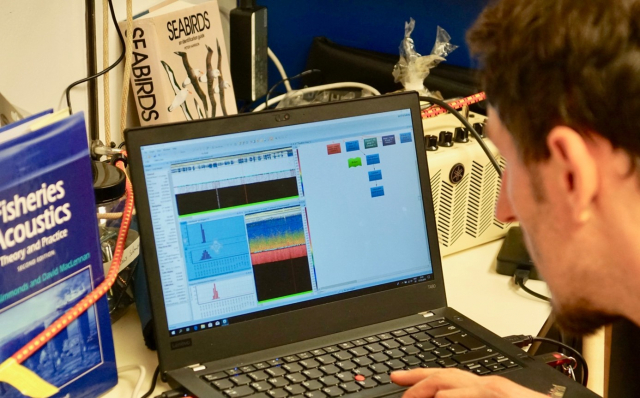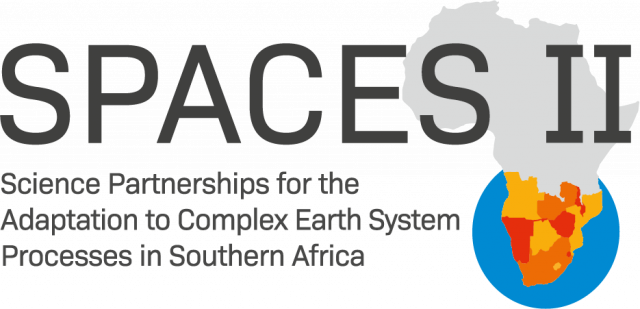Trophic TRAnsfer eFFICiency in the Benguela Current
Identifying differences in trophic pathways and ecosystem services in the Northern and Southern Benguela Upwelling Systems
TRAFFIC is a project involving five German and five Namibian and South African institutes. Its aim is to understand the reasons for the decrease in fishing yields in the northern Benguela current and the causes of the major changes in the southern part of the current in order to incorporate these into future sustainable management. Coastal upwelling systems account for about 20% of annual fish landings and thus play a significant role not only in the food supply of the world's population but also in the carbon and nutrient turnover in the ocean. Changes in the South-East Atlantic over the last decades have also changed ecosystem services, with different consequences in the northern and southern Benguela upwelling systems (see above, in addition to fisheries, e.g. CO2 uptake).
The Benguela current is one of the four highly productive coastal upwelling systems in the world whose export production is approximately as high as that of the unwilling system off Peru. However, the high phytoplankton productivity stands in surprising contratrast to the low productivity of the higher trophic levels: Fish, seabirds and seals. Nutrients that reach the surface during upwelling seem to be quickly re-exported, so that organisms of the higher trophic levels cannot effectively exploit the existing primary production.
Studying and understanding the causes of this development is not only of great scientific interest. It is also crucial for future management that the essential processes and limiting factors in an ecosystem are understood. Important drivers of such processes are the structure of the wind fields, the upwelling and the strength of the water currents. Since the conditions in the northern and southern parts of the Benguela upwelling system are very different, a comparison of these complex trophic systems and their interactions with fisheries and climate can provide important insights into the functioning of upwelling areas and their role in the global carbon cycle.
ZMT is responsible for the overall coordination of the project which consists of five sub projects. Two subprojects on carbon cycles and the role of small pelagic fish in the food web are under ZMT directive.
SUBPROJECT 1 (SP1)
SUBPROJECT 2 (SP2)
SUBPROJECT 3 (SP3)
SUBPROJECT 4 (SP4)
SUBPROJECT 5 (SP5)
SUBPROJECT 1 (SP1)
Primary Production, Phytoplankton, Microzooplankton, photoactive fitness
Intensive fishery pressure in the high productive Benguela Upwelling System caused a decline in fish stocks of small pelagic schooling fishes in the second half of the last century. While the fish stocks in the southern Benguela Upwelling slowly recovered, the ecosystem of the northern part did not return to its original status. TRAFFIC focuses on differences in structure between both food webs and its effect on the intensity of energy transfer rates. SP1 investigates the base of the food chain, the primary producers and the microzooplankton. In detail, differences in composition, abundance and photoactive fitness of primary producers between the northern and southern Benguela Upwelling System are analyzed. The composition of phytoplankton and microzooplankton determines the quality and quantity of food for higher trophic levels and is investigated in cooperation with Namibian partners.
The chlorophyll a content in the water column was measured during the expedition METEOR153 and will be inter-calibrated with remotely sensed data, assessed by our partners from South Africa, and correlated with physical-oceanographic data. The TRIAXUS, a gear equipped with several sensors (temperature, salinity, oxygen, nitrate, light, pigments, video plankton recorder, LOPC) was towed behind the ship during several transects and delivered a broad spectrum of data in the northern and southern part of the Benguela Upwelling System. These data will be made available to all sub-projects.
Regular meetings with the partners in Germany and southern Africa are planned for the whole project duration to inform each other about results and to discuss the progress of the project. During international meetings, project results will be presented and discussed. The results will be published in cooperation with the partners from Namibia and South Africa.

Deployment of 55 µm multiple closing net | Photo: Knut Heinatz; Universität Hamburg
Participants:
Dr. Rolf Koppelmann, IMF-UniHH
Prof. Dr. Christian Möllmann, IMF-UniHH
Dr. Bettina Martin, IMF-UniHH
Dr. Tarron Lamont, DEA, South Africa
Dr. Deon Louw, MFMR, Namibia
Sandy Thomalla, CSIR, South Africa
Tebatso Martin Moloto, CSIR, South Africa
SUBPROJECT 2 (SP2)
Our objective is to investigate both, the energy transfer efficiency and nutrients recycling efficiency of the biological carbon pump.
It is known that even small changes in the ratio of carbon to nutrients (C / N / P) of the exported organic material can significantly influence the uptake of CO2 by the biological carbon pump. Therefore, to understand its functioning, the determination of such ratios is fundamental.
We will deploy several sediment traps in the northern and southern Benguela Upwelling System to collect the exported organic material and furthermore collect plankton and water samples to ascertain C / N / P ratios in the planktonic biomass, in the fecal pellets expelled all along the trophic levels, and in the remineralized organic material. Additionally, we will measure CO2 fluxes between the ocean and the atmosphere. To assign C / N / P ratios to the seasonal variability of the two ecosystems, we will compare our results with the data gathered by our Namibian partners and with the findings in SP1.

Analysing data on board | Photo: Heino Fock, Thünen Institute
Participants:
Dr. Tim Rixen, ZMT
Claire Siddiqui, ZMT
Dr. Anja van der Plas, MFMR, Namibia
SUBPROJECT 3 (SP3)
Despite similar primary production rates, current fish production in the Benguela Upwelling System (BUS) is only about 10% of the amount of the Humboldt Current. Hence, in the BUS, biomass from primary production is not efficiently transferred up the food chains. Zooplankton, e.g. copepods and krill, are key organisms in marine food webs interlinking phytoplankton to higher trophic levels such as fish. The Marine Zoology working group at the University of Bremen, together with colleagues at the Leibniz Centre for Marine Tropical Ecosystem Research in Bremen and regional partner institutions in Namibia and South Africa, focus on this trophic link between primary producers and economically important fish. We investigate the pelagic food web structure, trophic interactions and the role of zooplankton in the overall trophic transfer efficiency. A comparison of the northern and southern BUS will help to understand the functioning of coastal upwelling areas and identify important drivers controlling fish recovery and recruitment, which will be essential for future sustainable fisheries in these areas. Zooplankton distribution, community structure and diel vertical migration will be studied concomitantly to relate trophic transfer efficiencies to zooplankton community composition and estimate their potential impact on the overall carbon flux.
More information here: https://www.uni-bremen.de/en/marzoo/research/projects

Sampling zooplankton | Photo: Holger Auel, Universität Bremen
Participants:
Dr. Holger Auel, BreMarE
Prof. Dr. Wilhelm Hagen, BreMarE
Dr. Maya Bode-Dalby, BreMarE
Dr. Hans Verheye, DEA, South Africa
Dr. Lynne Shannon, UCT, South Africa
Richard Horaeb, MFMR, Namibia
SUBPROJECT 4 (SP4)
SP4 investigates small pelagic species such as anchovy, sardine, sardinella and horse mackerel, and their role in the food web. This working plan will be implemented in close cooperation with our South African and Namibian partners.
In previous work, we focused on the early stages of fish development in the area of the northern BUS. Conversely, our South African partners, focused on adult individuals of the southern BUS. We will now expand the study to the entire fish size spectrum and examine the trophic position of the referred species in both northern and southern BUS.
We will use acoustic methods for biomass and size spectrum estimation and will integrate this information with existing datasets collected by our African partners. Like this, we will have a complete picture of the targeted species’ role in the overall ecosystem.

Analysis of hydroaccoustic data | Photo: Werner Ekau, ZMT
Participants:
Dr. Werner Ekau, ZMT
Dr. Tim Dudeck, ZMT
Carolin Müller, ZMT
Josephine Edward, MFMR, Namibia
Beau Tjizoo, MFMR, Namibia
Dr. Carl van der Lingen, DAFF, South Africa
Dr. Azwianewi Makhado, DEA, South Africa
Matt Horton, UCT, South Africa
SUBPROJECT 5 (SP5)
During two sea-going expeditions, the international team at Thünen Institute will investigate the distribution patterns and the vertical migration behavior of mesopelagic fishes. Hydro-acoustic measurements as well as net hauls will be taken with a research vessel. Closing nets allow for targeted sampling of fish from different depth zones, and various methods will be applied to obtain insight into the feeding behavior of the fishes.
More information here: https://www.thuenen.de/en/sf/projects/a-close-look-at-the-productivity-of-the-benguela-upwelling-system-traffic/

Retriving samples | Photo: Sina, Thünen Institute
Participants:
Dr. Anne Sell, TI
Dr. Heino Fock, TI
Sabrina Duncan, TI
Dr. Carl van der Lingen, DAFF, South Africa
Beau Tjizoo, MFMR, Namibia
Dr. Azwianewi Makhado, DEA, South Africa






